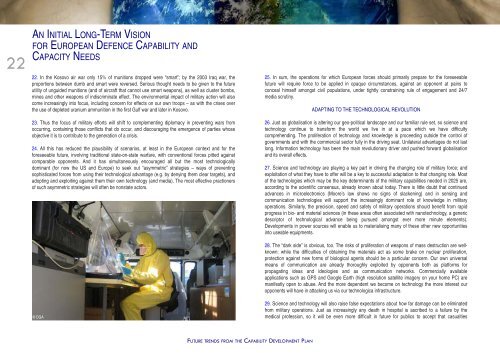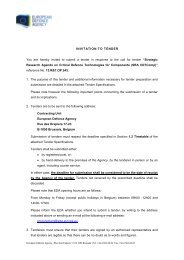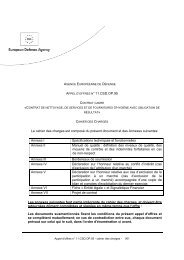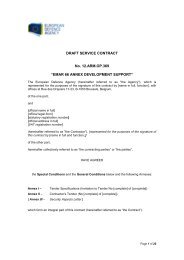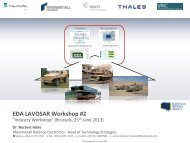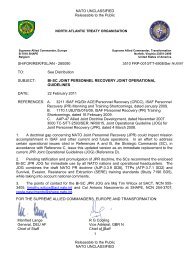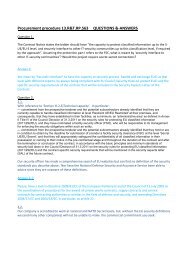capability development plan - European Defence Agency - Europa
capability development plan - European Defence Agency - Europa
capability development plan - European Defence Agency - Europa
Create successful ePaper yourself
Turn your PDF publications into a flip-book with our unique Google optimized e-Paper software.
22<br />
AN INITIAL LONG-TERM VISION<br />
FOR EUROPEAN DEFENCE CAPABILITY AND<br />
CAPACITY NEEDS<br />
22. In the Kosovo air war only 15% of munitions dropped were “smart”; by the 2003 Iraq war, the<br />
proportions between dumb and smart were reversed. Serious thought needs to be given to the future<br />
utility of unguided munitions (and of aircraft that cannot use smart weapons), as well as cluster bombs,<br />
mines and other weapons of indiscriminate effect. The environmental impact of military action will also<br />
come increasingly into focus, including concern for effects on our own troops – as with the crises over<br />
the use of depleted uranium ammunition in the first Gulf war and later in Kosovo.<br />
23. Thus the focus of military efforts will shift to complementing diplomacy in preventing wars from<br />
occurring, containing those conflicts that do occur, and discouraging the emergence of parties whose<br />
objective it is to contribute to the generation of a crisis.<br />
24. All this has reduced the plausibility of scenarios, at least in the <strong>European</strong> context and for the<br />
foreseeable future, involving traditional state-on-state warfare, with conventional forces pitted against<br />
comparable opponents. And it has simultaneously encouraged all but the most technologically<br />
dominant (for now the US and Europe) to seek out “asymmetric” strategies – ways of preventing<br />
sophisticated forces from using their technological advantage (e.g. by denying them clear targets), and<br />
adopting and exploiting against them their own technology (and media). The most effective practioners<br />
of such asymmetric strategies will often be nonstate actors.<br />
© DGA<br />
25. In sum, the operations for which <strong>European</strong> forces should primarily prepare for the foreseeable<br />
future will require force to be applied in opaque circumstances, against an opponent at pains to<br />
conceal himself amongst civil populations, under tightly constraining rule of engagement and 24/7<br />
media scrutiny.<br />
ADAPTING TO THE TECHNOLOGICAL REVOLUTION<br />
26. Just as globalisation is altering our geo-political landscape and our familiar rule set, so science and<br />
technology continue to transform the world we live in at a pace which we have difficulty<br />
comprehending. The proliferation of technology and knowledge is proceeding outside the control of<br />
governments and with the commercial sector fully in the driving seat. Unilateral advantages do not last<br />
long. Information technology has been the main revolutionary driver and pushed forward globalisation<br />
and its overall effects.<br />
27. Science and technology are playing a key part in driving the changing role of military force; and<br />
exploitation of what they have to offer will be a key to successful adaptation to that changing role. Most<br />
of the technologies which may be the key determinants of the military capabilities needed in 2025 are,<br />
according to the scientific consensus, already known about today. There is little doubt that continued<br />
advances in microelectronics (Moore’s law shows no signs of slackening) and in sensing and<br />
communication technologies will support the increasingly dominant role of knowledge in military<br />
operations. Similarly, the precision, speed and safety of military operations should benefit from rapid<br />
progress in bio- and material sciences (in these areas often associated with nanotechnology, a generic<br />
descriptor of technological advance being pursued amongst ever more minute elements).<br />
Developments in power sources will enable us to materialising many of these other new opportunities<br />
into useable equipments.<br />
28. The “dark side” is obvious, too. The risks of proliferation of weapons of mass destruction are wellknown:<br />
while the difficulties of obtaining the materials act as some brake on nuclear proliferation,<br />
protection against new forms of biological agents should be a particular concern. Our own universal<br />
means of communication are already thoroughly exploited by opponents both as platforms for<br />
propagating ideas and ideologies and as communication networks. Commercially available<br />
applications such as GPS and Google Earth (high resolution satellite imagery on your home PC) are<br />
manifestly open to abuse. And the more dependent we become on technology the more interest our<br />
opponents will have in attacking us via our technologica infrastructure.<br />
29. Science and technology will also raise false expectations about how far damage can be eliminated<br />
from military operations. Just as increasingly any death in hospital is ascribed to a failure by the<br />
medical profession, so it will be even more difficult in future for publics to accept that casualties<br />
FUTURE TRENDS FROM THE CAPABILITY DEVELOPMENT PLAN


